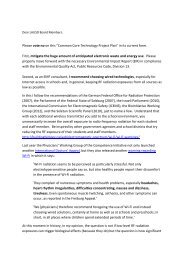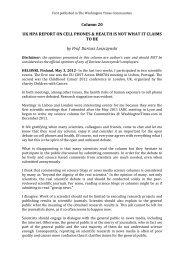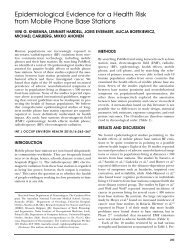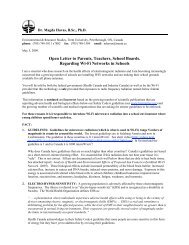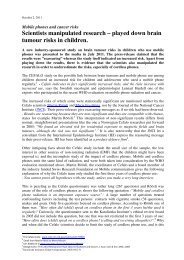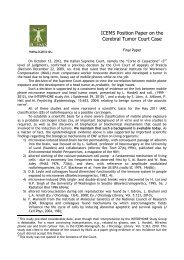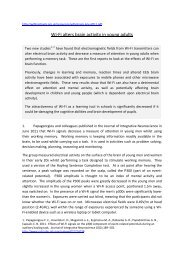Cindy Sage Letter to LAUSD - Electromagnetic Health
Cindy Sage Letter to LAUSD - Electromagnetic Health
Cindy Sage Letter to LAUSD - Electromagnetic Health
Create successful ePaper yourself
Turn your PDF publications into a flip-book with our unique Google optimized e-Paper software.
6. The <strong>LAUSD</strong> has the obligation <strong>to</strong> ensure that all campuses under its jurisdiction are in<br />
compliance with existing law and that all classroom occupants are appropriately<br />
protected from any potential adverse effects from wireless RFR exposures. <strong>LAUSD</strong> is<br />
required by law <strong>to</strong> conduct a full risk assessment of all <strong>to</strong>xic exposures by State code and<br />
this <strong>to</strong>xic exposure is not exempt. The evidence in 2012 is greater than in 2007 that RFR<br />
is associated with increased risk for cancer and neurological diseases; immune disorders,<br />
altered fetal brain development in pregnant women; sleep disruption, and impaired<br />
cognition, memory, learning, attention, concentration, and behavior in school children.<br />
7. New scientific studies of radiofrequency radiation of the kind and at the levels<br />
associated with wireless classroom environments report that chronic, whole-body RFR<br />
exposure at levels as low as 0.003 microwatts per square centimeter result in adverse<br />
health effects on children and adolescents (Thomas et al 2008; Heinrich et al 2010;<br />
Thomas et al 2010; Mohler et al 2010). Wireless classrooms will create unavoidable and<br />
involuntary exposure <strong>to</strong> RFR at levels shown <strong>to</strong> adversely affect memory, learning,<br />
cognition, attention, concentration and behavior <strong>to</strong> school occupants. No level of RFR<br />
exposure has been conclusively determined <strong>to</strong> be safe.<br />
• Thomas et al (2008) reported an increase in adult complaints of headaches and concentration<br />
difficulties with short-term cell phone use at 0.005 <strong>to</strong> 0.04 μW/cm2 exposure levels.<br />
• Heinrich et al (2010) reported that children and adolescents (8-17 years old) with short-term<br />
exposure <strong>to</strong> base-station level RFR experienced headache, irritation, and concentration difficulties<br />
in school. RFR levels were 0.003 - 0.02 μW/cm2.<br />
• Thomas et al (2010) reported that RFR levels of 0.003 - 0.02 μW/cm2 resulted in conduct and<br />
behavioral problems in children and adolescents (8-17 years old) exposed <strong>to</strong> short-term cell<br />
phone radiation in school.<br />
• Mohler et al (2010) reported that adults exposed <strong>to</strong> 0.005 μW/cm2 cell phone radiation (basestation<br />
exposure levels) had sleep disturbances with chronic exposure, but this effect was not<br />
significantly increased across the entire population<br />
8. For <strong>LAUSD</strong> <strong>to</strong> disregard existing health warnings from international science and<br />
public health experts by intentionally introducing technologies already shown <strong>to</strong> degrade<br />
learning environments would be reckless. It will create unnecessary liability for the<br />
District and will waste hundreds of thousands of dollars when wireless must eventually<br />
5



